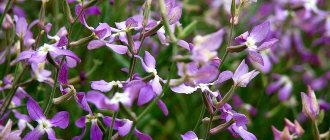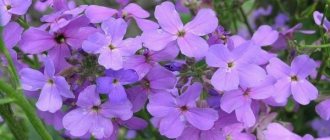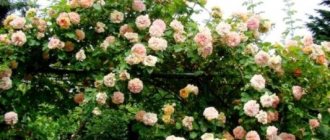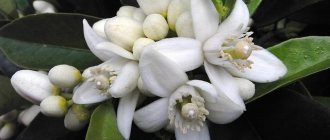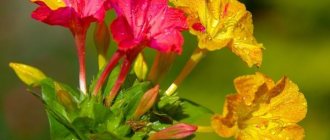Among the perennial ornamental plants, the nocturnal plant or night violet stands out with its unusual aroma. It has been grown in European gardens and parks since the 16th century. The night violet flower is called hesperis, from the Greek word “hesperis” - evening. The bright inflorescences open and begin to smell fragrant after sunset. Thanks to the plant's unpretentiousness and excellent decorative qualities, it is cultivated by gardeners all over the world. In Russia, nocturnal plants with lilac, purple and pinkish petals are most often found. But true lovers of hesperis will definitely grow varieties with snow-white and red double inflorescences.
The shape of hesperis inflorescences resembles phloxes
Botanical description and distribution
Matron's noctule or hesperis is a perennial herbaceous plant from the cruciferous (cabbage) family. It can be found in the Mediterranean, the Caucasus, Europe, Asia and Western Siberia. Gardeners brought the flower to North America, where it took root well. There are about 30 species of noctule. The shape of the inflorescences of Hesperis is similar to phlox; one of its many names is “bull phlox”. Under natural conditions it grows in meadows, forest edges, along ponds and roads.
The erect stem of the noctule reaches a height of 80-100 cm. It branches in the upper part. The leaves are green in color with jagged edges and lanceolate in shape. The size of the leaf plates is 3-4 cm wide and 12 cm long. They are covered with silky hairs. Small flowers are collected in loose racemes. The abundance of colors will delight gardeners - lilac, pink, violet, white and lilac shades will create a riot of colors in the flower beds. Each flower has 4 petals with a diameter of 2 cm or more.
Information. Night violet is a common name among decorative flowers. Hesperis is often confused with Matthiola bicorne, which is also called night violet.
The flowering of the brush begins in May and continues until the end of July. The petals gradually open from the periphery to the center of the inflorescence. The spectacular brush can grow up to 20-30 cm in length. The fruits of Hesperis are narrow, flattened pods with brown seeds arranged in two rows. Seed size is 3 by 1 mm. They have good germination, lasting up to two years. In hot weather, the flowering period is shortened. For the unique aroma that appears in the evening, the plant is called night violet.
Advice. Timely cutting of dried inflorescences will help prolong the flowering of noctule.
Decorative culture refers to biennials. In the first year of development, a dense rosette of oval lanceolate leaves is formed. In some cases, small flower stalks are formed. By the end of May of the second year, a stem with lush inflorescences will appear. From the third year, the ability to flower drops sharply, old plants give way to young ones.
How did I make friends with the night violet?
My acquaintance with the party took place after moving to my husband’s house. In the Khabarovsk Territory. I immediately took gardening into my own hands and, when preparing the beds for sowing in the spring, I pulled out all the plants that were unfamiliar to me. My mother-in-law did not expect such agility from me, and when she realized it, it was too late: I had killed the hesperis at the site.
I couldn’t help but be enthusiastic: in the very first season, a huge number of different bright summer birds were planted. Their lush flowering made it easy to convince loved ones that we would have the most blooming plot - from early spring until the first snow. At the same time, ornamental plants will be exclusively civilized. At the beginning of my independent gardening career, I treated savages with undeserved arrogance.
Hesperis bloomed in June at the neighbors' place - scattered throughout the area. Siberian, as I later determined. Its local name is “Japanese lilac,” which makes identifying this plant very difficult.
The pink and purple inflorescences looked pretty, growing over a meter in good garden soil, but from a distance they didn’t really impress me. At this time, I became concerned about growing paniculate phlox in such an unsuitable climate. Those close to me looked at my experiments with skepticism. By autumn, the mother-in-law collected ripened noctule seeds from neighbors and sowed them near the honeysuckle.
The breeding of phlox proceeded with great difficulty: after surviving one winter, they disappeared after the next. Some varieties fell out in the first winter; no shelter could save them.
The next spring, Hesperis sprang up thickly and, after thinning, vigorously began to grow, forming rosettes of lanceolate, rough leaves. I spent the whole season building up neat bumps. The sowing area was a bit dry and not particularly well lit, but it grew well in such conditions. The next year in June, when I was incredibly happy about the frail sprouts of the phlox that had survived the winter, the hesperis on meter-long stems had already bloomed.
From a distance, among the honeysuckle bushes, he looked very organic, and I softened somewhat towards this “savage”. And in the evening a wonderful aroma spread across the site, which finally reconciled me with his presence on the site. The next two days, when it was going to rain (but didn’t), it was cloudy and humid - the hesperis scented the whole area. And so for a whole month in the evenings and in cloudy weather. If it weren’t for the hungry Far Eastern mosquitoes lying in wait at every step, all evenings I would have found something to do near this wonderful aroma.
From that moment on, hesperis was allowed not only to grow and bloom, but also to bear fruit, which he immediately took advantage of. Its numerous children had to be removed in huge quantities in the spring, leaving them to grow where they were not particularly disturbing.
In nature, Siberian hesperis grows in damp places, but we didn’t have any of those on our site. It was quite happy with the dry neutral soil, grew well and bloomed.
Types of noctule
Most cultivated varieties have simple flowers, but double flowers are also found. In gardens and parks you can find several unpretentious, but fragrant and attractive plant species.
Matron's Evening Violet
An ornamental plant that prefers loose soil. Blooms in the second year of life. Purple flowers are collected in large cylindrical racemes. They have a strong, persistent aroma. Flower diameter is up to 2 cm. Can be grown by direct sowing in the soil in May-June.
Hesperis Romance
A popular decorative biennial with single or double white flowers. The plant is characterized by a persistent pleasant aroma exuded at night. It prefers light areas, but also feels good in partial shade. Used for cutting and designing group flower beds and paths.
Hesperis Inspiration
Branched biennial with simple flowers of lilac, purple or white color, collected in brushes. Prefers slightly alkaline soils. The plant is suitable for planting in mixborders or gardens. Height 80-90 cm. Abundant fragrant inflorescences will decorate any bouquet. It is frost resistant.
Matron's Evening Crimson
An unpretentious flower known as night violet. The branched, erect stems are decorated with many crimson flowers. At night and in the evening, the biennial spreads a pleasant fragrance. Blooms from May to July. Looks great as a background plant for landscape style gardens. Seedlings are planted in June at a distance of 30 cm from each other. Can reproduce by self-sowing.
Evening night beauty
One of the most fragrant varieties of hesperis blooms in the second year after planting. Its flowers of a soft lilac hue are collected in beautiful large brushes. The plant is resistant to frost and disease. It grows to a height of 50-75 cm. The flower is suitable for cutting and is used in group and single plantings. Can be grown on the balcony.
Evening party sad, dark
One of the rare plant species, Hesperis tristis L. Found in central and southern Europe. Its height is 25-50 cm. The light-loving and moisture-loving plant grows on clay and sandy soils. The brushes are large, the flowers are whitish or cream, covered with red veins. The petals are oblong in shape with a blunt tip, their length is 2-3 cm. It blooms from May to June. The leaves of the basal rosette grow up to 10 cm, the stem leaves are shorter.
Mattiola of Querdlinburg
Terry plants of this species are colored greenish. The foliage is bluish green, but the height depends on the variety.
Late matthiola grows more than 50 cm and forms a wide pyramidal bush with large flowers.
An early tall plant can have a stem height of up to 65 cm. They have large leaves and bright flowers in inflorescences. It begins to bloom in June and fades after two months.
The early low subspecies are spherical bushes not exceeding 50 cm in height. It has been blooming for a little over a month.
Selection of location and soil
It is recommended to plant night violets in lighted areas. In the lowlands, where meltwater stagnates and snowdrifts lie for a long time, it is better to plant plants. Excessive moisture will lead to rot on the leaves. Hesperis feels good in partial shade; it can be placed under the crown of a tree.
Priming
The plant grows well in slightly alkaline soils. It loves air, so loosening is advisable after each watering. Neutral fertile soil is also an acceptable option. But acidified peaty areas are unacceptable; the noctule will die on them. One of the significant agrotechnical measures is regular weeding. Weeds should not be allowed to grow.
Watering
Overmoistening is not desirable for night violets, so you should take care of drainage. During the growth period, it is necessary to provide sufficient watering, but without stagnation of moisture. Dryness leads to poor flowering. Watering is done once a week, preferably in the morning.
Top dressing
On depleted soil, before flowering, hesperis needs to be fertilized with complex mineral fertilizers. Then it is enough to add wood ash once a month. It will improve the structure of the soil and make it looser. Wood ash reduces soil acidity and increases plant resistance to infections.
Madonna's veil is resistant to frost, it can withstand temperatures down to -20°C. In winters with little snow, it is better not to risk the ornamental plant and cover it with non-woven material.
Growing Hesperis
Planting and caring for the night violet flower is not difficult; the photo shows how profusely it blooms when self-seeding in the field.
Madonna's noctule propagates in several ways: by seeds, seedlings and cuttings.
Advice. To prevent self-seeding plants from filling the entire flowerbed, plant young shoots every three years.
Seeds and seedlings
Noctule pods are harvested after the first frost. Small oblong brown seeds ripen in them. Seeds are sown in the spring after the soil warms up or in the fall. When sowing in spring, the beds are covered with plastic film, creating greenhouse conditions.
The plant also propagates by seedlings. To do this, you will need a container with loose soil fertilized with humus. Seeds are sown in early April, covered with a 5 mm layer of soil. The soil is watered from above and then covered with film. The containers are kept in a room with a temperature of 20°C. After 15-20 days, shoots appear. After the formation of three main leaves, the noctule plant is transplanted to a permanent place. They are seated 25-30 cm apart. During the adaptation period, the plant especially needs watering. The development of the root system is facilitated by air exchange, which ensures loosening. Weeds that slow down the growth of flowers should be promptly weeded.
Cuttings
Terry forms of hesperis do not reproduce by seeds. It is necessary to divide the bush in August-September. For cuttings, side shoots formed on the plant after flowering are used.
Caring for seedlings and planting in the ground
In general, caring for matthiola bicornuum seedlings does not cause any difficulties. The only operation that may raise questions for a beginner is picking , since the root system of the sprouts is superficial and weak, and can be easily damaged.
Picking seedlings
When the sprouts have formed 2-3 true leaves, the seedlings must be planted into individual pots.
Give preference to pots that will allow you to plant the plant in the ground without damaging its root system. These can be plastic pots with a removable bottom, peat or paper pots.
Abundant watering helps facilitate the replanting process. Some gardeners generally recommend placing a container with seedlings in a basin filled with water so that the soil is saturated with moisture and the sprouts are easier to remove from the soil.
For replanting, prepare a substrate from a mixture of loose turf soil, peat and sand.
Timing for planting seedlings in the ground
To plant seedlings in the ground, you need to choose a time when the threat of return frosts has completely passed. The optimal time for planting will be the second half of May - early June .
Soil requirements
Preference should be given to loose nutrient soils . On the one hand, it is necessary for the soil to retain moisture, preventing it from immediately seeping into the deep layers, but, on the other hand, retaining moisture in the soil for too long will lead to rotting of the root system.
Therefore, experienced gardeners recommend choosing soils with good drainage qualities , and filling the space between plantings with mulch. Mulching helps reduce natural moisture loss through evaporation.
Selecting a location
Matthiola bicornuum is a light-loving plant, but can also grow in a slightly shaded area.
You can choose a corner of the garden where there will be enough sunlight in the morning and evening hours, but in the midday heat the area will be in the shade .
In the first week and a half, young seedlings will need to be shaded from direct sunlight, especially at midday. Excessive amounts of ultraviolet radiation will lead to burns on the leaves of the sprouts and even death of the plants.
Specifics of growing matthiola bicornuum from seeds in open ground
Among flower growers there are many adherents of sowing seeds of flowering plants directly into the ground. Mattiola bicorne will not be an exception to this rule - it sprouts quite successfully when planted directly in the ridge.
Before planting, prepare the area:
- dig up;
- remove weed roots and stones;
- the soil is spilled with a weak solution of potassium permanganate to kill parasite larvae and fungal spores;
- the soil is enriched with humus and watered with a solution of complex fertilizer for flowering crops.
Then planting furrows are marked on the flowerbed (their depth should not be more than half a centimeter, and the distance between them should be about 30 cm).
The seeds are not planted too often, but they are guided by the need for further thinning of the plantings, so a distance of 5 cm between the seeds will be quite enough.
The furrows are sprinkled with soil and watered. The flowerbed can be covered with covering material, but you don’t have to do this. The first shoots will appear by the end of the second week .
Attention! If the seeds were sown in the ground in the fall, then seedlings should be expected only in the second spring after planting.
Seedling care
Caring for plantings consists of weeding, watering and regularly loosening the soil after the moisture has been completely absorbed.


